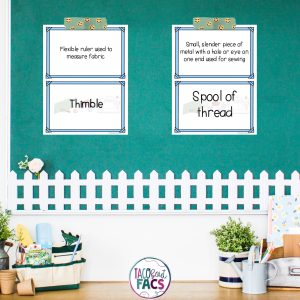Teaching 7th and 8th graders about the basics of cooking and sewing has lead me to the realization, they need more vocabulary knowledge.
Some students come to us with experience and understanding of cooking or sewing tools. Others are new to the game and are learning it all for the first time. I’m not sure about your classroom, but I also have several English Language Learners who definitely need extra opportunities to learn vocabulary.
I realize more and more just how fortunate I was to have family who valued learning how to cook and learning how to sew, but students are not being provided with those opportunities quite as often.
What does that look like in my FACS classroom?
I have four sections of 7th and 8th grade FACS 1 class and two sections of 8th grade FACS 2. With both classes, I have found the more vocabulary activities the better. In fact, even though I would like to believe the FACS 2 students have remembered everything from FACS 2, they sometimes need a reminder activity.
I have created and used gallery walks for both kitchen utensils and sewing tools. Both of these use commonly used tools/utensils and the definition for each word. The vocab word on the bottom is the guide for finding the matching definition.
This allows students to be up and moving around the room finding the matching tool or utensil with the definition. It is a great activity for FACS 1 students after learning the vocabulary and notes. It is also a great starter activity for FACS 2 students to test their knowledge before we dive deeper into a unit.
If you are interested in the vocabulary gallery walks, click on the links below the pictures. Both are FREE resources you can print, post on the wall, and use. It’s a simple prep and go activity.


One of my favorite parts of a gallery walk is that students can start anywhere. The vocab word is listed on the bottom and then students try to find the definition at the top of another page. As long as students are correct, they will continue to move around in a “circle” until they finally get back to their starting vocab word.
It’s a self-checking activity too. If students come back to a previously used word, there is an error. I am also a big fan of them using deductive reasoning to fix their mistake. It is a great test-taking strategy to practice.
Other ways I teach and review vocabulary and concepts is by using hexagonal thinking.
Hexagonal Thinking is a critical thinking activity that allows students to justify their thinking. There ar e no right or wrong answers if you can justify your thinking. It also provides a reflection piece for students to write about their reasoning and how that set of vocabulary can be used in real life.
You can read more about how I use hexagonal thinking in this blog post.
Of course, when students learn more about sewing and cooking as basic life skills, it is knowledge that will help them forever. However, building vocabulary seems to be one of the best ways I can support my students’ learning in other classes too.
When students build vocabulary in any subject, it pays off in all areas of the learning because this will help students use context clues and deductive reasoning when reading for understanding.
Grab the FREE resources below! You will love the simplicity of printing, posting, and using.
Get the sewing tools gallery walk activity for FREE here.
Get the kitchen utensils gallery walk activity for FREE here.